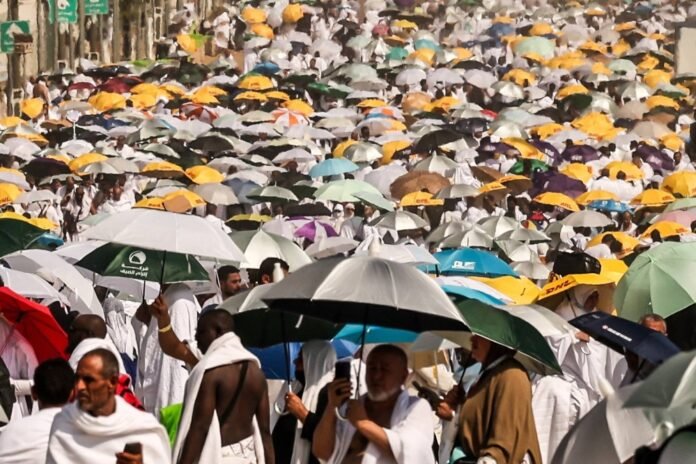Deadly heat waves mark the first day of summer in the Northern Hemisphere, LONDON – Deadly heat waves are scorching cities on four continents as the Northern Hemisphere marks the first day of summer — a sign that climate change could once again help fuel record-breaking heat that could surpass last summer as the warmest in 2,000 years.
Record temperatures in recent days are suspected to have caused hundreds, if not thousands, of deaths in Asia and Europe.
In Saudi Arabia, nearly 2 million Muslim pilgrims will end the hajj at the Grand Mosque in Mecca this week.
But according to reports from foreign authorities, hundreds of deaths occurred during the journey in temperatures above 51 degrees Celsius.
Egyptian medical and security sources said on Thursday that at least 530 Egyptians had died while participating – an increase from the 307 reported yesterday.
Another forty are missing.
According to the U.S. National Oceanic and Atmospheric Administration’s Earth Observatory, countries around the Mediterranean Sea have also endured another week of sweltering high temperatures that have contributed to wildfires from Portugal to Greece and along Africa’s northern coast in Algeria.
Members of the medical team evacuate a Muslim pilgrim affected by the scorching heat on Saturday during the annual Hajj pilgrimage. | AFP-Jiji
In Serbia, meteorologists predict temperatures of around 40 degrees Celsius this week, as winds from North Africa pushed a hot front across the Balkans.
Health authorities have declared a red weather alert and advised people not to go outside.
Belgrade’s emergency service said doctors intervened 109 times overnight to treat people with heart and chronic health problems.
In neighboring Montenegro, where health authorities also warned people to stay in the shade until late afternoon, tens of thousands of tourists sought refreshment on beaches along the Adriatic coast.
Europe is also experiencing a surge of dead or missing tourists this year amid the dangerous heat.
A wide swath of the eastern U.S. also wilted for the fourth day in a row under a heat dome, a phenomenon that occurs when a strong high-pressure system traps hot air over a region, preventing cool air from entering and causing ground temperatures to rise. stay high.

Construction workers drink water while working on a building in Pristina, Kosovo, during warm weather on Wednesday. | REUTERS
New York City opened emergency cooling centers in libraries, senior centers and other facilities.
While the city’s schools operated normally, some districts in surrounding suburbs sent students home early to avoid the heat.
Meteorological authorities also issued an extreme heat warning for parts of the US state of Arizona, including Phoenix, on Thursday, with temperatures expected to reach 45.5 degrees Celsius.
In nearby New Mexico, two fast-moving wildfires fueled by sweltering heat have killed two people, burned more than 23,000 acres and destroyed 500 homes, according to authorities.
Heavy rains could help dampen the fires, but thunderstorms on Thursday also caused flash flooding and complicated firefighting efforts.
All told, nearly 100 million Americans were under extreme heat advisories, watches and warnings on Thursday, according to the federal government’s National Integrated Heat Health Information System.
The brutal temperatures should start to drop in New England on Friday, the weather service said, but New York and the mid-Atlantic states will continue to endure near-record heat into the weekend.
Counting the dead
The summer period in India lasts from March to May, when the monsoons slowly move through the country and break the heat.

A man covers his face with a cloth to protect himself from the sun in New Delhi on Tuesday. | REUTERS
But New Delhi recorded its hottest night in at least 55 years on Wednesday, with India’s Safdarjung Observatory reporting a temperature of 35.2C at 1am.
Temperatures normally drop at night, but scientists say climate change is causing nighttime temperatures to rise.
According to a 2020 study from the University of Exeter, nights are warming faster than days.
New Delhi has clocked 38 consecutive days of maximum temperatures of 40 degrees Celsius or higher since May 14, according to weather bureau data.
An Indian health ministry official said on Wednesday that there were more than 40,000 suspected cases of heatstroke and at least 110 confirmed deaths between March 1 and June 18, as northwestern and eastern India recorded twice the usual number of heatwave days in one of the areas of the country. longest such spells.
However, obtaining accurate death tolls from heat waves is difficult.
Most health authorities attribute deaths not to heat, but rather to diseases worsened by high temperatures, such as cardiovascular problems.
Authorities therefore significantly underestimate heat-related deaths, typically missing thousands, if not tens of thousands, of deaths.
Record warm temperatures
The heat waves occur against the backdrop of 12 consecutive months and are the warmest on record in year-on-year comparisons, according to the European Union’s Climate Change Monitoring Service.

Tourists hold umbrellas to protect themselves from the sun as they walk near the Colosseum amid a heat wave in Rome on Thursday. | REUTERS
The World Meteorological Organization says there is an 86% chance that one of the next five years will eclipse 2023, making it the warmest on record.
While global temperatures have risen nearly 1.3 degrees Celsius above pre-industrial levels, climate change is causing even more extreme temperature spikes, making heat waves more common, intense and lasting longer.
Globally, a heat wave that would have occurred once every ten years in pre-industrial climates will now occur 2.8 times in ten years and it will be 1.2 degrees Celsius warmer, according to an international team of scientists with the World Weather Attribution (WWA). ) group.
Scientists say heat waves will continue to increase if the world continues to release climate-warming emissions from burning fossil fuels.
If the world reached 2 degrees Celsius of warming, heat waves would occur an average of 5.6 times in a decade and be 2.6 degrees Celsius hotter, the WWA said.



